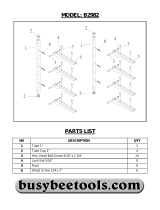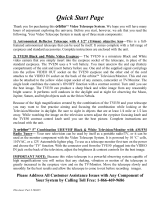
lower powers. It is quite common for an observer to own five
or more eyepieces to access a wide range of magnifications.
This allows the observer to choose the best eyepiece to use
depending on the object being viewed. At least to begin with,
the two supplied eyepieces will suffice nicely.
Whatever you choose to view, always start by inserting your
lowest-power (longest focal length) eyepiece to locate and
center the object. Low magnification yields a wide field of
view, which shows a larger area of sky in the eyepiece. This
makes acquiring and centering an object much easier. If you
try to find and center objects with high power (narrow field of
view), it’s like trying to find a needle in a haystack!
Once you’ve centered the object in the eyepiece, you can
switch to higher magnification (shorter focal length eyepiece),
if you wish. This is especially recommended for small and
bright objects like planets and double stars. The Moon also
takes higher magnifications well.
Deep-sky objects, however, typically look better at medium
or low magnifications. This is because many of them are
quite faint, yet have some extent (apparent width). Deep-sky
objects will often disappear at higher magnifications, since
greater magnification inherently yields dimmer images. This
is not the case for all deep-sky objects, however. Many galax
-
ies are quite small, yet are somewhat bright, so higher power
may show more detail.
The best rule of thumb with eyepiece selection is to start
with a low power, wide field, and then work your way up in
magnification. If the object looks better, try an even higher
magnification. If the object looks worse, then back off the
magnification a little by using a lower power eyepiece.
A. The Moon
With is rocky and cratered surface, the Moon is one of the
most interesting and easy subjects to view with your scope.
The best time to view it is during its partial phases when
shadows fall on the craters and canyon walls to give them
definition. While the full moon may look like a tempting target,
it is not optimal for viewing! The light is too bright and surface
definition is low.
Even at partial phases the Moon is very bright. Use of an
optional Moon filter to helps to dim the glare. It simply threads
onto the bottom of the eyepiece. You’ll find the Moon filter
improves viewing comfort, and helps bring out the subtle fea
-
tures of the lunar surface.
B. The Sun
You can change your nighttime telescope into a daytime Sun
viewer by installing an optional full-aperture solar filter over
the front opening of the telescope. The primary attraction is
sunspots, which change shape, appearance, and location
daily. Sunspots are directly related to magnetic activity in the
Sun. Many observers like to make drawings of sunspots to
monitor how the Sun is changing from day to day.
Important Note: Do not look at the Sun with any optical
instrument without a professionally made solar filter, or
permanent eye damage could result. Also, be sure to cover
the finder scope, or better yet, remove it altogether.
C. The Planets
The planets don’t stay put like the stars, so to find them you
should refer to Sky Calendar at our website telescope.com, or
to charts published monthly in Astronomy, Sky & Telescope
,
or other astronomy magazines. Venus, Mars, Jupiter, and
Saturn are the brightest objects in the sky after the Sun and
the Moon. Your SkyQuest IntelliScope is capable of showing
you these planets in some detail. Other planets may be visible
but will likely appear starlike. Because planets are quite small
in apparent size, optional higher power eyepieces are recom
-
mended and often needed for detailed observations. Not all
the planets are generally visible at any one time.
JUPITER The largest planet, Jupiter, is a great subject for
observation. You can see the disk of the giant planet and
watch the ever-changing positions of its four largest moon:
Io, Callisto, Europa, and Ganymede. Higher power eyepieces
should bring out the cloud bands on the planet’s disk and the
Great Red Spot.
SATURN The ringed planet is a breathtaking sight. The tilt
angle of the rings varies over a period of many years; some
-
times they are seen edge-on, while at other times they are
broadside and look like giant “ears” on each side of Saturn’s
disk. A steady atmosphere (good seeing) is necessary for a
good view. Look closely and you should see the Cassini divi
-
sion, a thin, dark gap in the rings. You should also see one
or more of Saturn’s moons, which look like faint stars. The
brightest is the moon Titan.
VENUS At its brightest, Venus is the most luminous object in
the sky, excluding the Sun and the Moon. It is so bright that
sometimes it is visible to the naked eye during full daylight!
Ironically, Venus appears as a thin crescent, not a full disk,
when at its peak brightness. Because it is so close to the Sun,
it never wanders too far from the morning or evening horizon.
No surface markings can be seen on Venus, which is always
shrouded in dense clouds.
MARS The Red Planet makes a close approach to Earth
every two years. Observing Mars is most favorable at these
times. You should see salmon-colored disk with some distinct
dark patches, and you may be able to spot a whitish polar ice
cap. To see surface detail on Mars, you will need a high power
eyepiece and very steady air!
D. The Stars
Stars will appear as tiny points of light. Even powerful tele
-
scopes cannot magnify stars to appear as anything more than
pinpoints. You can, however, enjoy the different colors of the
stars and locate many pretty double and multiple stars. The
famous “Double-Double” in the constellation Lyra and the gor
-
geous two-color double star Albireo in Cygnus are favorites.
Defocusing a star slightly can help bring out its color.
E. Deep-Sky Objects
Under dark skies, you can observe a wealth of fascinating
deep-sky objects; that is, objects that reside outside of our
solar system. These include gaseous nebulas, open and
globular star clusters, and a variety of different types of galax
-
ies. The large apertures of SkyQuest IntelliScope Dobsonians
are particularly well suited to gathering light, which is critical
16





















